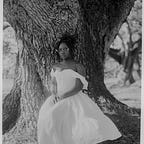siempre bruja — trust me, keep watching
this ain’t quite a think piece, but i’ve been giving myself the space to be still and ‘binge’ on netflix and have wound up about halfway through the first season of Siempre Bruja, a netflix orginal produced by Colombian production house Caracol TV and directed by Ana María Parra. US-based black folks, i’ve talked to briefly, about the show have all expressed an initial discomfort or even disgust with the 17th century interracial romance between Carmen, an enslaved afro-colombian woman with the power to heal herself and others, and Cristobal, her Master’s son. Its a tired narrative that we all know better than to fall for(a la Sally Hemings). Enslavement is broadly considered an inappropriate context for this kind of melodrama, but i guess i’m writing because I feel strongly that there is a bigger story being told and i don’t want my folks to miss it.
To be frank, I am positively obsessed with black women’s negotiations of self-making and self-fashioning in the wake of the trans-atlantic slave trade. i think about it. i read about it. i write about it. i dream about it. i even craft campy burlesque routines about it.
and where diasporic popular culture is concerned, I know that slavery is not an uncommon theme for Telenovelas (Brazil has had several that were veryyyyy popular for a plethora of reasons that deserve interrogation. *wink,wink* John Mundell)
In the first episode of Siempre Bruja when an out of place, and out of time fugitive Carmen, stumbles into a courtyard in 2019 Cartegena and is confronted by the rememory of the area as a market square, full of enslaved black women laughing with each other, I saw a dissertation chapter writing itself before my eyes.
My initial response to these dismissals (i.e. “she really doing all that tryna save her master?”) came from the part of my brain trained in african diaspora studies and familiar with the ways ‘mestizaje’ doctrines and other colonial imperatives have created understandings of enslavement and interraciality throughout the non-english speaking african diaspora that cannot be easily reconciled within a north american lens. part of what excited me about ‘Siempre Bruja’ when promo-materials were first circulated was how little i knew about slavery in Colombia. this is not to excuse the overdone romanticism, but to say that seeing how Colombian popular culture ‘spins’ slavery to make sense of it’s own contemporary racial politics seems like a worthwhile experience for anybody trying to deepen their diasporic awareness (those folks should also read Tianna Paschel’s Becoming Black Political Subjects ).
there’s much to critique in the show. For one the gang of white Colombians (+ the black gay bestie) that surrounds Carmen interacts with her and her body in ways that make me suck my teeth and roll my eyes. she is sweet and naive but exotic nonetheless and the script will not let us forget that.
I don’t wanna give any spoilers, but episodes 4+5 mark a transformation in the plot that i think all those hesitant to engage a story driven by misplaced intimacy will appreciate. These episodes give deliberate attention to Carmen as a black woman bound to the past and hungry for the future. She loses her memory and has to decide how she will relate to her history and that relation will determines who she is to become. A black witch who can heal but never love or a normal, albeit stunning, biology student.
In one moment I can’t stop thinking about, Carmen looks into a mirror while being chastized by a white Colombian classmate for things i can’t discuss without giving too much away. “Which one of them are me?” She asks as the classmate stares at her confused. The camera pans to the mirror and we see present-Carmen standing between the coy and enslaved version of herself and deliberately sexy, flirtatious modern version of her self. “Well, I’m neither that one nor that one,” she says and laughs out of the hallucination.
In this moment we glimpse black femininity as a haunted spectrum between over-burdened and unbridled. Carmen stands in between, confused, and I watch her with wide eyes, all of my black feminist imaginary falling into the space between the writers intentions and the way the scene lands in my body. This two episode arc follows Carmen to her birth home which is also hosting a festival in honor of La Virgen Candaleria (The Black Madonna). Here what I presume to be an afro-colombian folkloric dance troupe stages a performance of the burning of black witches. Carmen is witness to the millennial restaging of her history. she get to see the ways other young black women engage with her story. she gets to see herself in the crying eyes of the black madonna. and in that seeing she remembers. (cue: rapture of black feminist performance studies jouissance)
i’ll stop here (because i’d like to get back to the show!) but ya’ll — keep watching past our own shadows… let the uneasy parallels inform your seeing but don’t look away! if you watch the whole series and are still like…what the fuck who put spanish melodrama and sci-fi in my slavery? MY BAD, but at least you will have spent a few hours with the gorgeous
Angely Gaviria.
***and if anybody knows more about the shows reception among afro-colombian’s (like do they have access to it? is it streaming in Colombia on Public Broadcast?) let’s talk!
